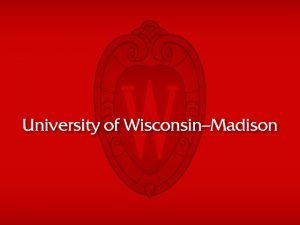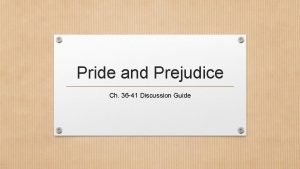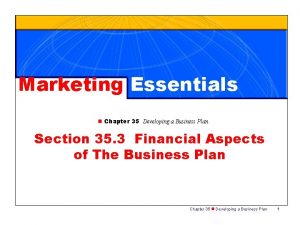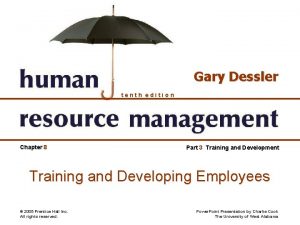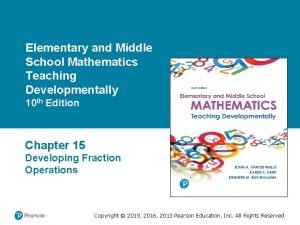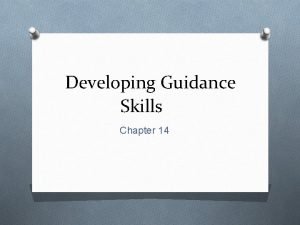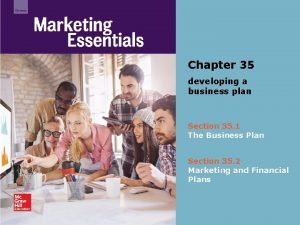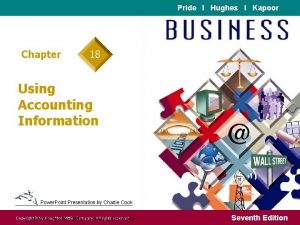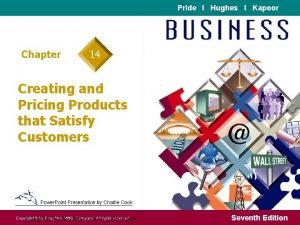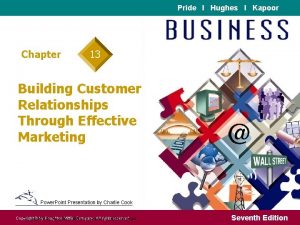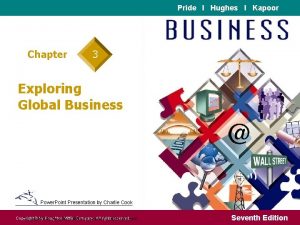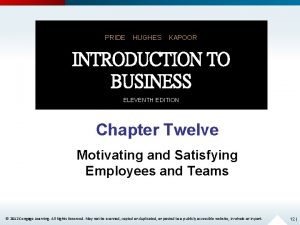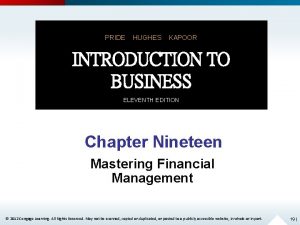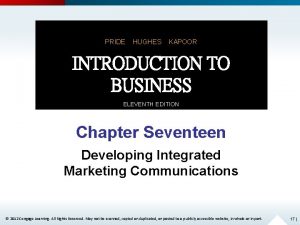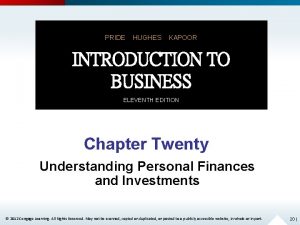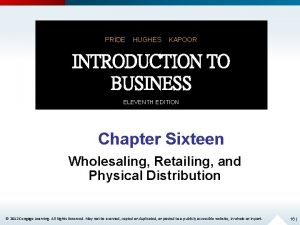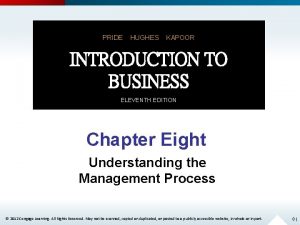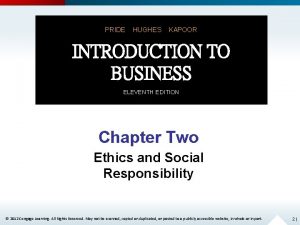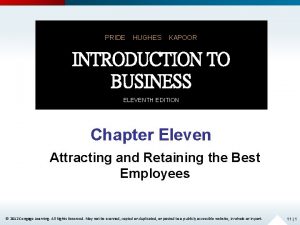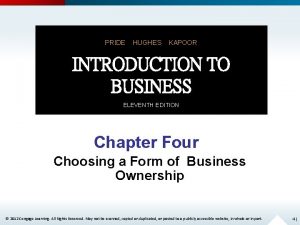Pride I Hughes I Kapoor Chapter 16 Developing















- Slides: 15

Pride I Hughes I Kapoor Chapter 16 Developing Integrated Marketing Communications Power. Point Presentation by Charlie Cook Copyright © by©Houghton Mifflin Company. All rights reserved. Copyright by Houghton Mifflin Company. All rights reserved. Seventh Edition

The Role of Promotion • Promotion – Communication about an organization and its products that is intended to inform, persuade, or remind target market members. • The role of promotion – To facilitate exchanges directly or indirectly by informing individuals, groups, or organizations and influencing them to accept a firm’s products or to have more positive feelings about the firm. • Convey product and service information directly to target market segments. • Provide information to interest groups, regulatory agencies, investors, and the general public. – To maintain positive relationships between a company and various groups in the marketing environment. Copyright © by Houghton Mifflin Company. All rights reserved. 2

The Promotion Mix: An Overview • Promotion mix – The particular combination of promotion methods a firm uses to reach a target market. The mix typically consists of: • Advertising—a paid, nonpersonal message communicated to a select audience through a mass medium. • Personal selling—personal communication aimed at informing customers and persuading them to buy a firm’s products. • Sales promotion—the use of activities or materials as direct inducements to customers or salespersons. • Public relations—communication activities used to create and maintain favorable relations between an organization and various public groups, both internal and external. Copyright © by Houghton Mifflin Company. All rights reserved. 3

Possible Ingredients for an Organization’s Promotion Mix Depending on the type of product and target market involved, two or more of these ingredients are used in the promotion mix. Advertising Public relations Personal selling Sales promotion Source: William M. Pride and O. C. Ferrell, Marketing: Concepts and Strategies, 2000 e. Copyright © 2000 by Houghton Mifflin Company, Adapted with permission. Copyright © by Houghton Mifflin Company. All rights reserved. Figure 16. 2 4

Advertising • Types of advertising by purpose – Primary-demand advertising—used to increase demand for all brands of a product in a specific industry. – Selective-demand (brand) advertising—used to sell a particular brand of product. • Immediate-response advertising—to persuade customers to buy the product within a short time. • Reminder advertising—designed to keep the firm’s name fresh in the public’s mind. • Comparative advertising—compares specific characteristics of two or more brands to show the advertiser’s brand is better. – Institutional advertising—designed to enhance a firm’s image or build its reputation. Copyright © by Houghton Mifflin Company. All rights reserved. 5

Growth of Advertising Expenditures and Employment in Advertising 1972 Total advertising expenditures and employment in advertising have been increasing for several decades. 116, 000 $29 billion 1977 132, 000 $39 billion 1982 159, 000 Number of people employed $67 billion Amount of money spent 1987 212, 000 $110 billion 1992 232, 000 $131 billion 1999 290, 000 $215 billion Source: Reprinted with permission from the May 22, 2000 issue of Advertising Age. Copyright © Crain Communications, Inc. , 2000; and U. S. Department of Labor Bureau of Labor Statistics, Employment and Earnings, April 2000, p. 74. Copyright © by Houghton Mifflin Company. All rights reserved. Figure 16. 3 6

Advertising (cont’d) • Advertising Media: The forms of communication through which advertising reaches its audience. – Newspapers—relatively inexpensive and timely; short life span. – Magazines—reach a specific market segment; more prestigious than newspapers; allows for high-quality reproduction; lack of timeliness. – Direct-mail advertising—promotional material mailed directly to individuals. – Outdoor advertising—short promotional messages on billboards, posters, and signs. – Television advertising—the primary medium for larger firms whose objective is to reach national or regional markets. – Radio advertising—offers selectivity based on a station programming format targeted to specific groups of listeners. – Internet advertising—increasingly popular new medium that reaches target audiences through unique new methods such as banner and button ads, sponsorship ads, keyword ads, and e-mail messages with CPM rates comparable to other media. Copyright © by Houghton Mifflin Company. All rights reserved. 7

Distribution of Advertising Expenditures among Various Advertising Media Television 23. 4% ($50. 4 billion) Newspapers 21. 7% ($46. 6 billion) Direct mail Radio Yellow Pages Magazines 19. 2% ($41. 4 billion) 8. 0% ($17. 2 billion) 5. 9% ($12. 7 billion) 5. 3% ($11. 4 billion) Internet 0. 9% ($1. 9 billion) Outdoor 0. 8% ($1. 7 billion) Other In 1999 just over 45 percent of all advertising dollars were spent on newspaper and television advertising. 14. 8% ($31. 8 billion) Source: Reprinted with permission from the May 22, 2000 issue of Advertising Age. Copyright © Crain Communications, Inc. , 2000. Copyright © by Houghton Mifflin Company. All rights reserved. Figure 16. 4 8

Advertising Expenditures and Sales Volume of the Top Ten National Advertisers Source: Reprinted with permission from the September 25, 2000 issue of Advertising Age, p. 52 and S 52. Copyright Crain Communications, Inc. , 2000. Copyright © by Houghton Mifflin Company. All rights reserved. Table 16. 1 9

Personal Selling • Kinds of salespersons – Order getter—a salesperson who is responsible for creative selling: selling the firm’s products to new customers and increasing sales to present customers. – Order taker—a salesperson who handles repeat sales in ways that maintain positive relationships with customers. – Sales support personnel—employees who aid in selling but are more involved in locating prospects, educating customers, building goodwill for the firm, and providing follow-up service. • Missionary salespersons—visit retailers to encourage an initial purchase of the manufacturer’s products from wholesalers. • Trade salespersons—work with customers to promote and increase retail sales of the manufacturer’s products. • Technical salespersons—assist current customers with technical matters related to the manufacturer’s products. Copyright © by Houghton Mifflin Company. All rights reserved. 10

Sales Promotion Methods • Consumer sales promotion method – A method designed to attract consumers to particular retail stores and to motivate them to purchase certain new or established products. • Trade sales promotion method – A method designed to encourage wholesalers and retailers to stock and actively promote a manufacturer’s product. Copyright © by Houghton Mifflin Company. All rights reserved. • Factors influencing the choice of sales promotion method – Objectives of the sales promotional effort – Product characteristics – Target market profile – Distribution channels – Availability of resellers – Competitive and regulatory forces in the environment 11

Sales Promotion Methods (cont’d) • Important sales promotion methods – – – – – Rebate—returning part of the purchase price. Coupon—reducing the purchase price at the time of purchase. Sample—a free product to encourage customer trial. Premium—a gift offered to customers for buying the product. Frequent-user incentives—a program that rewards customers’ repeat (frequent) purchases of the product. Point-of-purchase displays—promotional material in the retail store designed to inform customers and encourage purchases. Trade shows—industry-wide exhibits of sellers’ products Buying allowance—a temporary price reduction to resellers for purchasing specified quantities of a product. Cooperative advertising—the seller pays a portion of the retailer’s advertising costs for advertising the seller’s product. Copyright © by Houghton Mifflin Company. All rights reserved. 12

Public Relations • Public relations – A broad set of communication activities used to create and maintain favorable relationships between an organization and various public groups, both internal and external: • Customers, employees, stockholders, suppliers, educators, the media, government officials, and society in general • Types of public relations tools – Written and spoken communications • Brochures, newsletters, company magazines, annual reports, press releases, and speeches – Event sponsorship • Special events such as concerts and charity functions that the firm underwrites wholly or partially Copyright © by Houghton Mifflin Company. All rights reserved. 13

Public Relations (cont’d) • Publicity – Communication in news-story form about an organization, its products, or both. • News release—a typed page about 300 words long provided by the organization to the media as a form of publicity. • Feature article—a piece (up to 3, 000 words) prepared by the organization for inclusion in a particular publication. • Captioned photograph—a picture accompanied by a brief explanation. • Press conference—a meeting at which invited media personnel hear important news announcements and receive supplementary textual materials and photographs. Copyright © by Houghton Mifflin Company. All rights reserved. 14

Public Relations (cont’d) • The uses of public relations – To promote people, places, activities, ideas. – To enhance the reputation of the organization by increasing awareness of company products and activities. – To create specific positive company images. – To maintain the public visibility of the company. – To reduce the effects of negative events on the company’s reputation. Copyright © by Houghton Mifflin Company. All rights reserved. 15
 Shray kapoor
Shray kapoor Somya kapoor
Somya kapoor Ankit v kapoor
Ankit v kapoor Mark hughes jill hughes
Mark hughes jill hughes Chapter 18 pride and prejudice
Chapter 18 pride and prejudice Volume 3 chapter 10 pride and prejudice
Volume 3 chapter 10 pride and prejudice Pride and prejudice chapter 36
Pride and prejudice chapter 36 Being mr wickham
Being mr wickham Pride and prejudice chapter 57
Pride and prejudice chapter 57 Pride and prejudice chapter 30 summary
Pride and prejudice chapter 30 summary Chapter 3 iron man
Chapter 3 iron man Chapter 35 developing a business plan
Chapter 35 developing a business plan Chapter 8 training and developing employees
Chapter 8 training and developing employees Chapter 15 developing fraction concepts
Chapter 15 developing fraction concepts Guidance skills definition
Guidance skills definition Chapter 35 developing a business plan
Chapter 35 developing a business plan


